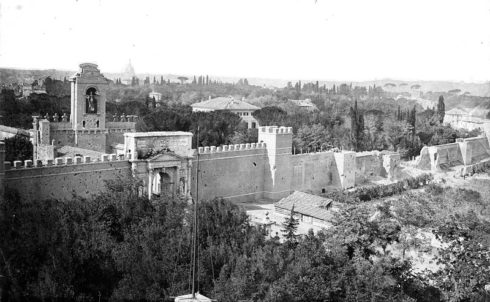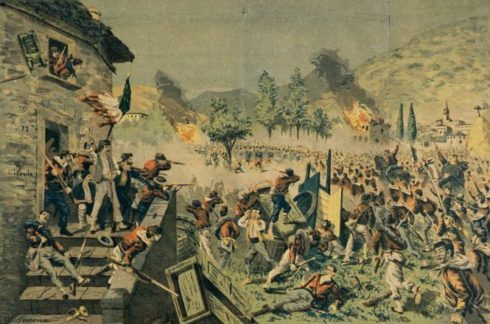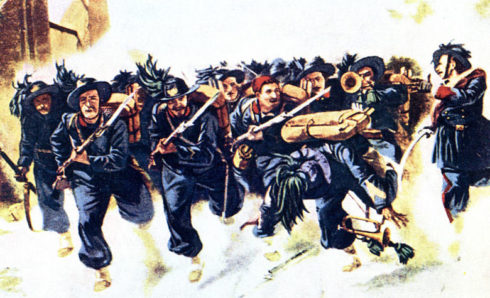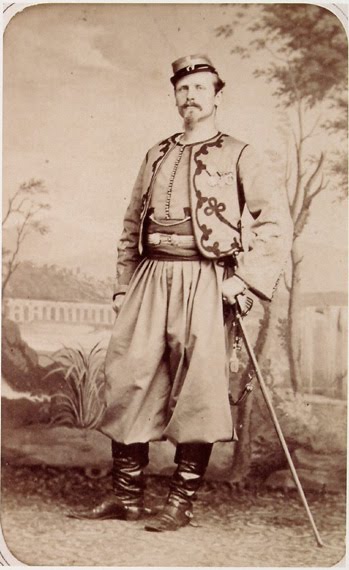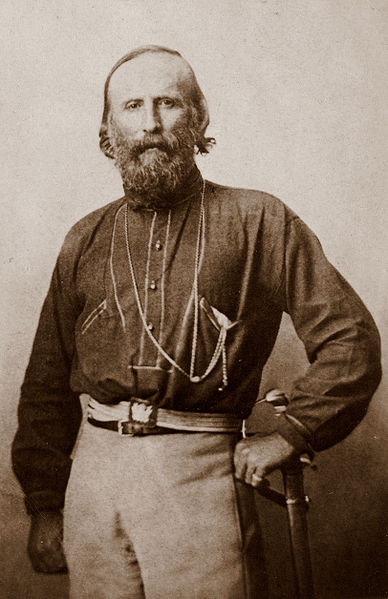It was a dark and gloomy morning, pouring rain, when this little army of some five thousand men filed out of the Porta Pia in a colorful parade, Pius IX’s Swiss General Rafael de Courten’s papal troops leading and the French contingent bringing up the rear….
Famous since classical times as a suburban retreat some twenty kilometers away from Rome, Mentana had known its share of history, thanks to its position on one of the major routes to the capital city. The battle that engulfed the town on November 3, 1867, would fix Mentana forever in the Italian imagination….
Garibaldi occupied the town with between four and ten thousand troops. The continuing flow of desertions made a proper count difficult….Whatever discrepancies there may be in records of their numbers, the Redshirts had the advantage in terms of the terrain.
General Kanzler’s forces pursued them hotly, however. The 3,000-man papal contingent, commanded by General Rafael de Courten was in the vanguard, lugging their percussion rifles. The French column of roughly 2,000, commanded by General Baron de Polhés brought up the rear. Although the French were under strength, their line battalions were equipped with the new rapid-repeating chassepot rifle.
Kanzler’s troops arrived at the approaches to Mentana in the early afternoon of November 3. Just a few miles from the village, he sent three companies of the Zouaves around the Redshirts’ right flank, up the valley of the Tiber to cut the road between Mentana and Monte Rotondo. With the dragoons at the front, the remaining papal soldiers marched on the Via Nomentana, with the French following a mile or so behind.
Almost immediately the main column saw action. They punched through Garibaldi’s three forward battalions, positioned as they were on both sides of the road, in the woods, on the heights of Monte Guarneri, and in dug-in positions within the Santucci Vineyard.
 Shortly after noon, the papal scouts encountered the first Garibaldian outposts. Four companies of Zouaves, led by Captains d’Albiousse, Thomalé, le Gonidec, and Alain de Charette (brother of the colonel), moved in light skirmishing order, and quickly cleared the Redshirts out of the woods. Then Colonel de Charette himself arrived. He led the Zouaves in a furious bayonet charge, driving the Garibaldians from their positions. At last they reached the walled and fortified Santucci Vineyard. The 1st and 4th companies of the Legion of Antibes along with the carabinieri soon arrived to act as reserves.
Shortly after noon, the papal scouts encountered the first Garibaldian outposts. Four companies of Zouaves, led by Captains d’Albiousse, Thomalé, le Gonidec, and Alain de Charette (brother of the colonel), moved in light skirmishing order, and quickly cleared the Redshirts out of the woods. Then Colonel de Charette himself arrived. He led the Zouaves in a furious bayonet charge, driving the Garibaldians from their positions. At last they reached the walled and fortified Santucci Vineyard. The 1st and 4th companies of the Legion of Antibes along with the carabinieri soon arrived to act as reserves.
The Santucci vineyard, with its wall and strongly built house, was a formidable obstacle. The Redshirts laid down a furious wall of fire, and the Zouave assault faltered. The balls flew like flies and opened holes in the papal ranks. But Charette rode up and shouted, “Advance, Zouaves, or I will be killed without you!” Then, carrying on the point of his sword the red bonnet of a Garibaldian officer whom he had just killed, he charged the enemy.
The Zouaves stormed the compound and fought a quick, furious skirmish with the Redshirts. Colonel de Charette’s horse was shot from under him, while Captain de Veaux died from a bullet that drove into his heart the cross of valor he had won at Castelfidardo. The surviving foes fled, leaving house and vineyard to the Zouaves.
The next Redshirt-held obstacle on the road was an unused monastic building called Il Conventino. Kanzler placed six of his guns there to cover his men from the enemy artillery fire coming from the castle. He then sent a company of Zouaves to flush the Redshirts out of Il Conventino, with five companies of Swiss carabinieri in support. But under the command of the impetuous Colonel de Charette, the Zouaves refused to wait for any assistance and charged the enemy positions pell-mell.
By early afternoon, the Redshirts were driven from Il Conventino and their neighboring positions. The papal artillery was then set up on Monte Guarneri. But this relatively easy advance was not to last. Most of Garibaldi’s troops had dug in around the walled village and the castle on the hilltop. Their artillery battery was behind the town, up on Monte San Lorenzo. In a pitched set of attacks and counterattacks on the steep slopes leading up to Mentana itself, the Redshirts halted the papal advance. They then launched an enveloping counterattack on both flanks of Courten’s men.
One of Garibaldi’s two flanking columns almost succeeded in capturing two companies of the Swiss carabinieri. But these fell back in good order, firing as they did so; unexpectedly more of the Swiss arrived. The tide of the attack then turned as the carabinieri became the pursuers, charged the Redshirts, and, breaking their line, chased them up the road toward Monte Rotondo. The second column of Redshirts fared no better. Their intended target, the Légion of Antibes, likewise turned the tide of action and became the attackers. The Garibaldians were forced to flee before them into Mentana itself.
Unable to communicate with Garibaldi, for reasons that will shortly become clear, his commanders resolved to throw everything they had—reserves and all—into a frontal attack. Up to this point, the vastly outnumbered papal forces had done all of the fighting, to the annoyance of the French. But seeing fresh Redshirts pouring out of Mentana, Kanzler asked Baron de Polhés to deploy his men.
Meanwhile, Colonel Allet’s Zouaves had been steadily advancing on the road to Monte Rotondo. Before they could reach it, however, Garibaldi and his staff fled, leaving his hapless troops to continue the struggle. Allet was a rock. All through the fray, the colonel had been quietly smoking a cigar. He then saw a Garibaldian out of the corner of his eye. Without showing any emotion, Allet watched as the Redshirt took aim at him. The Garibaldian fired and the colonel was unwounded. Turning to the Zouaves, Allet called out while laughing: “Oh! How stupid he is! He aimed, he fired, and he didn’t kill me! Give me your rifle,” he said to a nearby Zouave. The colonel shouldered the rifle, aimed it at the Garibaldian, fired, and the Redshirt fell dead. When the Zouaves did cut the road, the Redshirts’ doom was sealed, though they were not as yet aware of it.
Just as the Zouaves were cutting off the Redshirts’ line of retreat, the French had pushed through around the Redshirts’ left flank. Their position in Mentana collapsed. The chassepot rifle, not as yet used on any battlefield, was now employed by those of the French troops who had been issued them (according to Colonel Du Picq’s account, not all of Napoleon’s soldiers had them). The sound of these new rifles, so different from anything ever heard before, caught the attention of both sides. In a little while, the Garibaldians all over the battlefield broke and ran….
Garibaldi himself had not been content with flight to Monte Rotondo; he had gone farther back to Corese. Accompanying him were five thousand survivors, at least half of his entire force. The other two Redshirt columns who had previously pulled back from Rome withdrew as well.
Charles A. Coulombe, The Pope’s Legion: The Multinational Fighting Force that Defended the Vatican (New York: Palgrave MacMillan, 2008) pp. 134-139.
